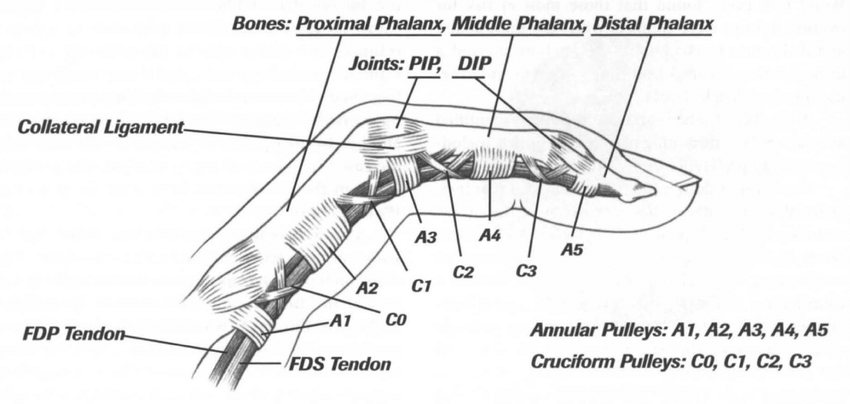Pulley Education
Recently, I taught a class on wrist strengthening at Pacific Pipe Climbing Gym and someone asked “what is a pulley?” I gave a quick explanation of the anatomy, function, and how they become injured during climbing. I thought I’d write a blog post to more thoroughly discuss this information.
What is a pulley?
The pulley is a bi-laminar ligament that circles around the finger flexor tendons in the hand. There are 5 annular pulleys on each finger (the ones commonly referred to as it relates to climbing injuries) and 2 on the thumb. A pulley’s function is to enhance the mechanical advantage of the finger flexors by keeping the tendons close to the bone. The pulleys are like a hug for your tendons. Check out this photo for a visualization. . .
Why do pulleys get injured?
Pulley sprains and ruptures are the most common injury within the climbing community. When the fingers flex (bend to grip a hold) the finger tendons place a certain amount of force through the pulleys. During rock climbing there is an exceptional amount of force placed on the pulleys because of the various grip positions. It has been shown that the crimp/ full crimp position is the most strenuous for the pulleys, specifically A2. Pulleys can also get injured when feet slip while climbing and basically shock loading the pulley.
How does a pulley injury present?
Climbers with pulley injuries usually report a pop, swelling, will have pain to palpation at the pulley site, decreased range of motion, and decreased strength. There are clusters of clinical tests that a clinician will use to differentiate a pulley sprain from a finger tendon strain, lumbrical/ interosseous strain, collateral ligament sprain, fracture, or another problem in the area. The most reliable way to diagnose a pulley injury is by diagnostic ultrasound or other imaging like MRI.
How to prevent pulley injuries?
Warm up the hands. The pulleys themselves aren’t well vascularized and warming them up may be useful. Perform finger tendon glides x 20, finger stretches open/ closed x 50, and very low grade climbing to ensure the hands are warm and mobile. One research study said that 100 moves is an appropriate warm up. . . Whoa!
It has been shown that the pulleys are placed under less load during open hand positions and slopers. The A2 pulley has up to 30-times more force placed on it when crimping! Practice using open hand grip and avoid full crimping when able to reduce the force through the pulleys.
Avoid pockets in the first two years of climbing. The pulleys do get stronger over time, but it takes several years. Steering away from pockets, especially on challenging routes where your feet may cut or you’re pulling hard, for the first few years will ensure you’re not putting a ton of strain on one or two fingers before the pulleys are strong enough to handle it.
What to do if you think you injured a pulley?
Pulley injuries are most often managed conservatively without surgery. Find a trusted Physical Therapist in your area for a thorough assessment to determine if you have a pulley sprain, and if so, what grade sprain. This diagnosis will help guide what is best to focus on for rehab and return to climbing. Timelines can be anywhere from 6 weeks to 6 months depending on severity.
References:
Roloff I, Schöffl VR, Vigouroux L, Quaine F. ( 2006). Biomechanical Model for the determination of the forces acting on the finger pulley system. J Biomech.
Schöffl, V., Schöffl, I., Frank, L., Küpper, T., Simon, M., & Lutter, C. (2020). Tendon Injuries in the Hands in Rock Climbers: Epidemiology, Anatomy, Biomechanics and Treatment-An Update. Muscles, Ligaments & Tendons Journal (MLTJ)
Schoffl I., Oppelt K., Jungert J., Schweizer A., Neuhuber W., Schoffl V. 2009. The influence of the crimp and slope grip position on the finger pulley system. Journal of Biomechanics 42 2183–2187
Vigouroux L, Quaine F, Labarre-Vila A, Moutet F. 2006 Estimation of finger muscle tendon tensions and pulley forces during specific sport-climbing grip techniques. Journal of Biomechanics. 39 2583-92
Schweizer A., Frank O., Ochsner P.E., Jacob H.A. 2003. Friction between human finger flexor tendons and pulleys at high loads. Schweizer A, Journal of Biomechanics 36 63-71
June 13, 2022
